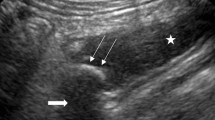Abstract
Calcifications are frequently seen on radiographs of the abdomen. The purpose of this section is to demonstrate the typical appearance of the more commonly occurring calcifications. Location and morphology are key characteristics to identify when evaluating abdominal and pelvic calcifications. For instance, gallstones are sometimes seen as round calcifications in the right upper quadrant. Knowing the typical appearance and location helps the diagnosis. What percentage of gallstones are radiopaque? Check out the Gallbladder chapter to find out.
Access provided by Autonomous University of Puebla. Download chapter PDF
Similar content being viewed by others
Keywords
FormalPara Objectives:-
1.
Describe the patterns of calcification and their location on radiographs for the following: chronic pancreatitis, vascular structures, uterine fibroids, appendicolith, and renal calculi.
-
2.
Describe the usefulness of an oblique view for assessing the localization of abdominal calcifications.
-
3.
State what percentage of renal calculi are normally visible on the plain radiograph.
Calcifications are frequently seen on radiographs of the abdomen. The purpose of this section is to demonstrate the typical appearance of the more commonly occurring calcifications. Location and morphology are key characteristics to identify when evaluating abdominal and pelvic calcifications. For instance, gallstones are sometimes seen as round calcifications in the right upper quadrant. Knowing the typical appearance and location helps the diagnosis. What percentage of gallstones are radiopaque? Check out the Gallbladder chapter to find out.
Chronic Pancreatitis
Figure. 25.1 shows multiple calcifications of variable size in the mid upper abdomen and left upper quadrant. These are calcifications within the pancreas of a patient with chronic pancreatitis.
Vascular Calcifications
Vascular calcification takes several forms. In Fig. 25.2, numerous small, round, smoothly marginated calcifications are noted representing phleboliths within pelvic veins. Phleboliths are calcified venous thrombi. They often contain a central lucency that relates to recanalization of the occluded veins.
Figure. 25.3 shows calcification of the abdominal aorta. Sometimes the calcification is extensive enough to outline an abdominal aortic aneurysm, as in this case. Concerning calcifications on abdominal radiographs should prompt additional evaluation for abdominal aortic aneurysms with modalities such as ultrasound or CT.
Uterine Fibroids
Various tumors, both benign and malignant, may calcify. Figure. 25.4 demonstrates popcorn-like calcification noted in uterine fibroids, the most common tumor found in the pelvic region. Fibroids are “almost” universally benign.
Appendicolith
Figure. 25.5 is an abdominal radiograph on a patient with right lower quadrant pain. A calcification is seen in the right lower quadrant. This is an appendicolith, a calcified stone within the appendix. When this finding is seen in association with acute right lower quadrant pain, appendicitis should be strongly considered.
Urinary Tract Calculi
Calcifications projected over the renal outlines or over the expected course of the ureters are often seen since 90 % of renal calculi are sufficiently radiopaque for visualization on the plain radiograph (Fig. 25.6). Certain calcifications may overlie the renal outline on a frontal projection but be displaced from the renal outline on oblique views because they are anterior or posterior to the kidneys. Their exact location can be surmised by knowing the obliquity of the radiograph and the direction in which the calcifications would be expected to move with rotation.
Now CT is often the first study performed to localize and quantify calcifications in the urinary tract. Calcium-containing stones such as calcium oxalate and calcium phosphate stones are radiopaque and usually seen on plain radiographs. Radiolucent stones such as uric acid, indinavir, and pure matrix stones are radiolucent and are not usually visualized on plain radiographs.
Author information
Authors and Affiliations
Editor information
Editors and Affiliations
Rights and permissions
Copyright information
© 2015 Springer International Publishing Switzerland
About this chapter
Cite this chapter
Singh, H., Neutze, J.A., Enterline, J.R. (2015). Abdominal Calcifications. In: Singh, H., Neutze, J., Enterline, J. (eds) Radiology Fundamentals. Springer, Cham. https://doi.org/10.1007/978-3-319-10362-4_25
Download citation
DOI: https://doi.org/10.1007/978-3-319-10362-4_25
Published:
Publisher Name: Springer, Cham
Print ISBN: 978-3-319-10361-7
Online ISBN: 978-3-319-10362-4
eBook Packages: MedicineMedicine (R0)










